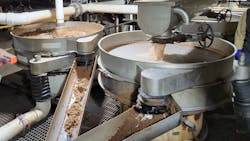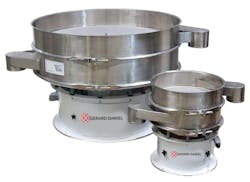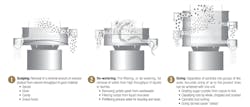Vibratory separator machines for food and beverage applications
Every sector of the food and beverage processing industry has an extensive need for separation and filtration. This article discusses vibratory separation machines (also called round separators, vibratory sieves, sifters, screeners) — sizing and selection, and recognizing the different ways manufacturers and suppliers can and should prioritize customer needs.
Separator machines have been among the most useful processing machines for decades, spanning industries and applications. In some businesses they are nearly as ubiquitous as the pallet jack. The food and beverage sector is no exception. Over the last 80 years it seems the wheel has been reinvented and better mousetraps have been built while the technology of vibratory separators has changed very little. It is fair to say that the technology is pretty much settled.
Technical support and advice
So, if little has or seemingly will change with these machines, then where can manufacturers and sellers of sifters find improvements to better serve their customers in food and beverage and other process industries? Where can processors find improvements to better serve their customers? The opportunity for improvements lay less in machine design and more in the relationship and technical support provided to each customer.
Just as vibratory separators and screens are not one-size-fits-all, the separator manufacturer’s technical support should not be either. The customer base for these machines falls roughly into four categories, and the right level of technical advice respects the needs of each.
- Some customer interactions are purely transactional. That is, they know exactly what they want, which is the same thing they ordered last year, and the year before that. They do not want to be upsold on something different. It is just a reorder. A good mesh expert is still available to review whether their mesh choice is providing the optimal throughput and durability, but mostly stay out of the way.
- New customers who have little experience with separators, are unfamiliar with their capabilities and who might have little technical know-how might be overwhelmed by all of the choices. They want some technical guidance from an application engineer without feeling like they are being pressured to buy something they do not fully understand.
- In between those two are customers who may have some past experience with separator machines or are themselves engineers with a technical background. They like to do their homework first but would still like to discuss their options with an application engineer to make sure they have not missed anything.
- OEM customers who need to incorporate a separator into a processing line that they sell as a package. They will be ordering many of the same machine and expect them to be tailored to integrate seamlessly into their process. When they speak to a technical consultant they expect an application expert, not just a sales contact.
For any of these categories of customer, being met with the wrong one of these technical approaches can be unhelpful and off-putting. Respecting every customer begins with establishing and demonstrating credibility in each of these categories. An engineering-led company that decouples technical service from customer sales commissions is best suited to demonstrate to each and every customer that their best interests are the top priority. Offering online machine sizing and selection tools, instructional materials and no-pressure customer guidance from experts allows each type of customer to engage on their own terms at their own comfort level.
The shift from sales contacts to application engineers has yielded customer support improvements in the form of demystifying the selection process. Online selection calculators and tutorials have helped to inform the customer. Many separator manufacturers have decoupled sales from commission, giving customers a peek behind the curtain to see that sizing and configuring these machines really does take extensive expertise.
Selection
The following is a table of applications and examples typical of the food and beverage processing industry. Vibratory separators have been used in these ways for as long as they have been around. The utility of these machines depends on how they are configured. Each one of these examples requires different wire mesh screens, different accessories and different adjustments to the machine, and all must be sized to the customer’s production rate.
Screen tips
An integral part of selecting the right machine is the matter of selecting a screen optimized for the application. Among the standard offerings indicated in the sizing tutorial above, there are a number of types of separation screens characterized by different porosity ranges, combinations of opening sizes and % of open area. Each has different properties that make them suitable for specific tasks. A separator machine manufacturer has wire mesh specialists that can assist in determining the right mesh for your process application.
Is it demystified enough yet? Unfortunately, demystify does not necessarily mean simplify. If being handed an equation to solve does not excite you, that is ok. The best way to get exactly what you need is to talk to a vibratory screener manufacturer for the perfect solution. They can not only help with all the sizing and selection, but they can even run samples of your product to ensure it meets your needs before you buy.
Keeping your process flowing
Once you have determined the basic machine, you may also need to consider whether to incorporate screen cleaning solutions. Because the material is sorted through a wire mesh screen, some materials tend to clog the mesh openings, effectively limiting the capacity of the machine’s throughput. To avoid stopping the process to clean and restart frequently, separator machine manufacturers offer several different types of mechanical cleaning systems that continually de-blind, or de-clog, the screen surface as the machine runs.
Determining the best type for your application depends on understanding how the material behaves under each deblinding method. This is another important area where a consultative approach on the sale is going to save a ton of aggravation down the road.
Larry Koehn is technical application manager – separation products, at Gerard Daniel Worldwide.
Gerard Daniel Worldwide
Sizing a separator machine
First, understand your material and objectives. Is your product or medium wet or dry?
If your product is wet, it’s best to contact the machine manufacturer for assistance. They’ll need to know the type of material you want to screen and the liquid, as well as the volume of both. Some users with wet applications are simply separating solids from wastewater as in a commercial laundry, while others are sorting food products, like liquid chocolate. Each is very different, and an applications engineer can be very helpful here.
If your product is dry, do you need simple separation or multiple sizing options? This will determine if a single screen deck is sufficient or if you need several decks.
Calculating the right size machine
Start by selecting the screen you need by using a standard Screen Mesh Selection Table. The screen type — whether it’s a Tensile Bolting Cloth, Mill Grade or Market Grade -- will be determined by its function plus its mesh opening in inches or microns, and its open area. Select the screen to allow your particles to pass through the screen opening. If you are unsure, contact the machine or screen manufacturer for help.
Identify the following additional factors:
- Capacity of your desired screen from the mesh table in lb/ft2= C
- Pounds per hour of material you want to pass through a single deck = M
- The percentage of material you expect to pass through the screen = Q
- The bulk density of your product measured in lb/ft3. If you don’t know, weigh a 5-gallon bucket full of your material and divide it by .67. Density = D
Use the following formula to calculate required screen and machine size: Surface area required (ft2) = M * (Q/100)/(C*D/100)
Then,
- Multiply that result by 1.25 to account for a 25% margin of error. Depending on how you set up and dial in your machine, nominal volume throughput may vary in actual use.
- Select the machine from the table below with a screen surface area equal to or greater than your desired throughput:
Machine Range 18” dia. 24” dia. 30” dia. 48” dia. 60” dia.
Area, ft2 1.5 3 4 12 18
About the Author
Larry Koehn
Technical Application Manager – Separation Products, Gerard Daniel Worldwide
Larry Koehn is Technical Application Manager – Separation Products, at Gerard Daniel Worldwide. He can be reached at [email protected].


